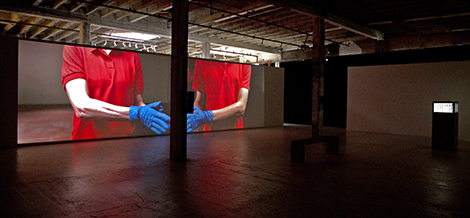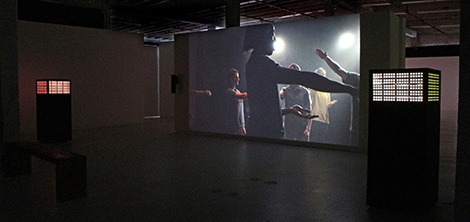Factories are not settings that usually inspire meditative or poetic work, but for artist Surabhi Saraf, the connection makes perfect sense. Saraf, who was born in Indore, India, grew up playing around the machinery and workers at her parents’ pharmaceutical factory. With training in Indian music and dance, and an MFA in Art and Technology from the School of the Art Institute of Chicago, the San Francisco-based new media artist recently presented her multichannel video installations “Remedies” at the Potrero District’s Hosfelt Gallery.
Saraf, the recipient of a 2015 Eureka Fellowship Award, expands on the concept of earlier works, such as Fold{Live} (2011), which uses simple, everyday motions—the folding of laundry—as a point of departure for exploration of the significance in small gesture. Initially envisioning her new work as a sound piece, Saraf obtained recordings of the machinery—some archaic, some state-of-the-art—at the factory. She soon realized she wanted to add a video component, and began exploring gesture, wearing sensors that would enable her to choreograph using her body, to interpret the rhythms and patterns of the motions in the factory.
“Remedies” consists of two large, immersive multichannel video installations that also incorporate square pedestals, “video boxes” and images of pharmecutical products moving past us in a grid, as though on an assembly line. In the larger gallery space, Tablets (2014) features a hypnotic soundtrack of percussive sounds, its two wall-sized projections creating a cinematic experience. Performers wearing red polo shirts and blue plastic gloves enact precise, almost robotic choreography. Arms raise and lower, come together and part, at times like a semaphore code, at others like a piston. A sinuous body roll becomes a motif. Lines of bodies step forward, or backward, sometimes in a circular motion. Hands make a gesture as though shaking or twisting something open, grasping and pulling. With a fine choreographic touch (the artist here collaborated with Christy Funsch), one might think of Sarah Michelson’s spare, repetitive works; the pieces also convey much of the suspense and drama of Bill Viola.
Capsules (2014) is enriched by a more orchestral soundtrack; surrounding the viewer, sound is a key element in the work, and designed to spill over from one work to another. Dancers appear in pairs or small groups, the whole ensemble joining for a finale, with an incessant beat like Stravinsky’s Rite of Spring, and a scooping, sifting and flinging motion involving some actual powdered substance that makes clouds of dust in the air.
One’s sense of the bodies of the performers as transformed into a symbiosis of man and machine is quite striking, and might convey a sense of a dystopian society where humans have evolved into cyborgs, but Saraf’s intent is more benign. Her interest in the sounds and motions of the factory is of a more formal nature, bypassing the potentially loaded politics of factory labor or drug companies. Questions about these issues may, no doubt, arise unbidden in the minds of many viewers. But we may enjoy the piece, as intended, as a hypnotic and compelling meditation on an alchemical transformation—of raw elements into healing potions.


